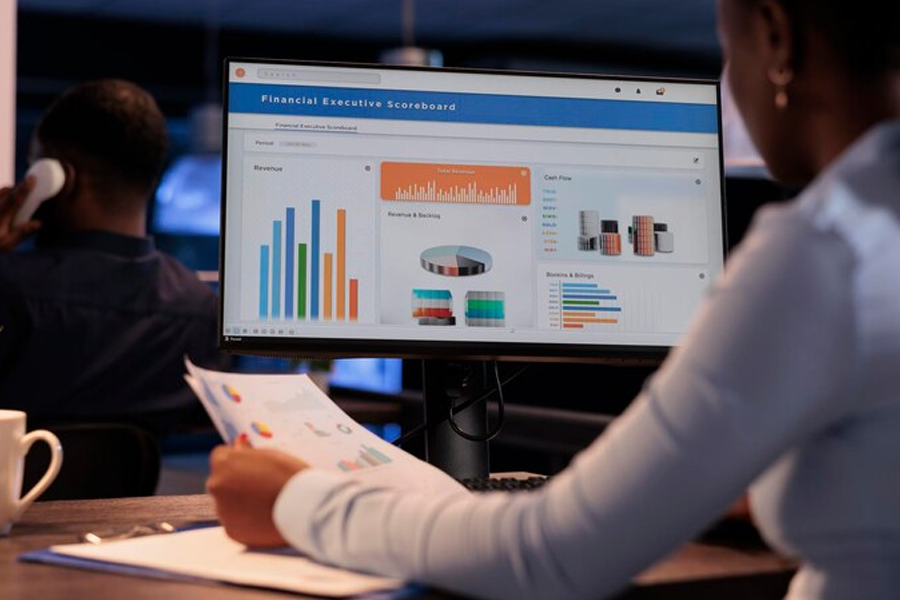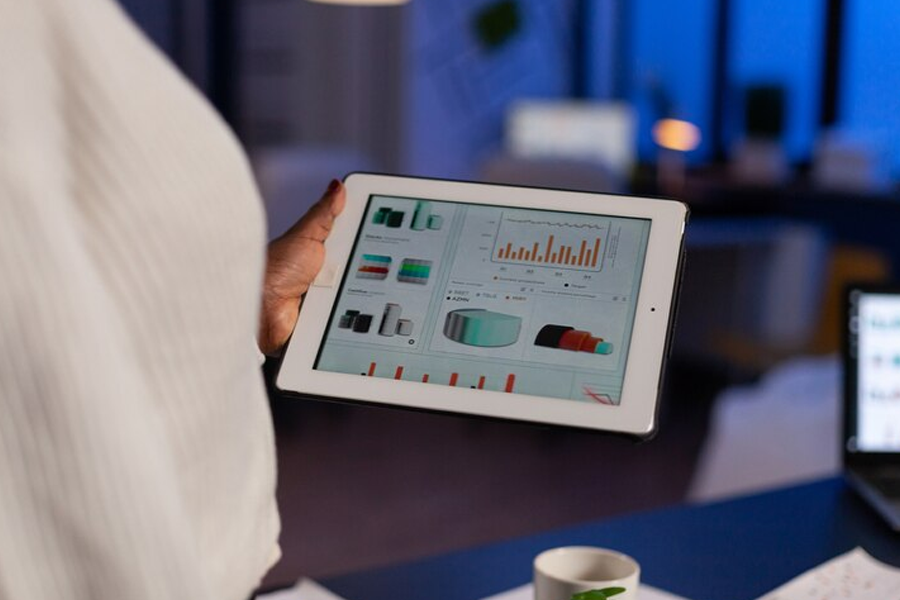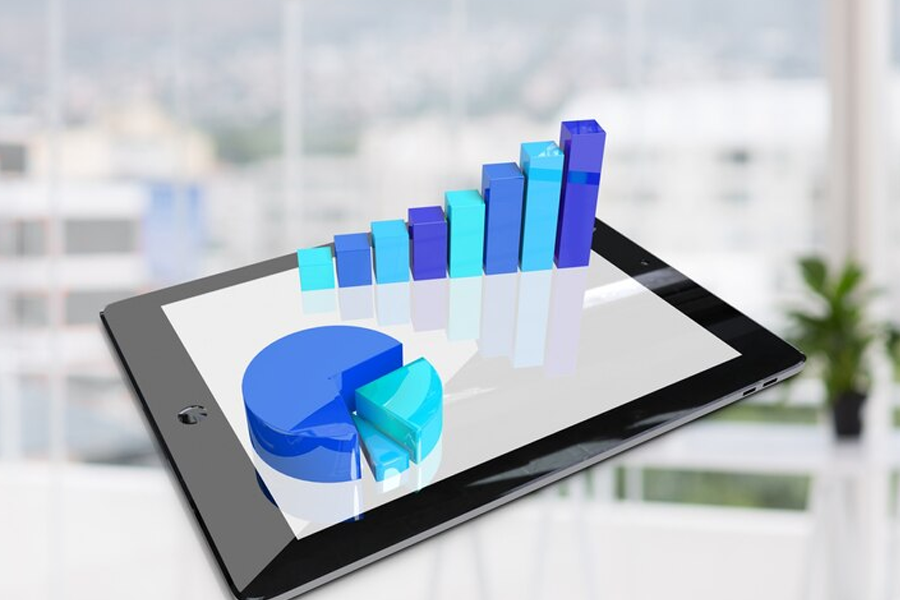Data visualization tools make it easy to understand and visualize data. As an ecommerce entrepreneur, these software programs are designed with the primary goal of helping you make sense of the data you’ve gathered for growth.
Therefore, this article will guide you through how to use data visualization tools to improve your ecommerce business operations.

Introduction to Data Visualization for Ecommerce
Owning an ecommerce business makes it important for you to know what data visualization is as you’ll be needing it for your day-to-day business. It involves translating information within a dataset to visual or graphical representation such as maps, charts or tables.
Visual elements like charts, graphs, and maps have stayed with humanity for so long because they help to simplify complex concepts into easy-to-understand graphics.
And for ecommerce businesses, success can be achieved when large, complex datasets are broken down easily into simple and digestible bits of information. It’s no wonder pie charts, bar charts, and tables have continued to remain relevant in ecommerce.

Understanding Your Ecommerce Data
You will need to visualize your data first before you can make sense of it. This is especially if you are an ecommerce business owner or manager handling big data on a regular basis which means you will need to use data visualizations to make sense of it all.
In the below lines, we will explain why this is important.
Customer Behavior
You will need a visual representation of your customer journey from landing on your site to completing a purchase. You will also need to identify drop-off points and optimize those steps for better conversion rates.
In addition, visualizing user interactions on your website such as frequently clicked buttons or viewed products is necessary to enhance user experience.
Product Performance
Bar charts or pie charts can help to highlight your best-performing products which will enable you to identify trends and adjust marketing or inventory strategies accordingly.
You will also need to manage your inventory effectively by visualizing stock levels to avoid overstock or stockouts.
Customer Segmentation
You will need to understand your customer base with demographic breakdowns. And then you can adjust your marketing messages and strategies based on these insights.
Your ecommerce data also involves tracking groups of customers who made their first purchase in the same time frame to understand their behavior over time for more targeted marketing. This can be achieved using ecommerce analytics tools, which can help you make a better decision based on your business’ performance.
Competitor Analysis
Competitor analysis is data as well. You will need to compare your product prices with competitors visually. This will enable you to adjust your pricing strategies to stay competitive.
Visualizing your market share will help you understand your market share data and use this information to refine your business strategy.
Sales Performance
Your sales performance over time is data that needs to be tracked. You’ll be able to identify peaks, valleys, and patterns using line charts or graphs to help you understand seasonal variations or product popularity. Maps can also help to display where your sales are concentrated, aiding targeted marketing efforts and inventory planning.
It’s important to translate key aspects of your ecommerce operations into visually appealing graphics so that you can identify areas that need improvement or adjustments. Without visualizing your data, you’ll not be able to understand it which can cause you to map out irrelevant and unclear growth strategies for your business.
Benefits of Data Visualization for Ecommerce Growth
Your ecommerce business can benefit in a number of ways from data visualization.
Below are a few of them to check in detail:
- Informed Decisions: When you present data in a visual representation, you are able to wade through the complexities to dig out clear insights that will enable you to make informed decisions.
- Personalized Marketing: Data visualizations can help you to understand your customer demographics which will guide you in tailoring your marketing messages and offers. Personalized approaches help to enhance customer engagement and loyalty.
- ROI Tracking: Visualizing the return on investment (ROI) for different marketing channels allows you to effectively allocate budgets to areas of your ecommerce business that require improvement. It also helps you to identify high-performing campaigns which you can replicate in the future.
- Real-Time Monitoring: Visualizations enable real-time monitoring of key metrics. This agility allows your ecommerce business to adapt quickly to market changes, staying ahead of trends and outpacing competitors.
- Effective Reporting: Visualizations serve as powerful tools for all types of reports for your business, making it easier to communicate complex data to various stakeholders. This fosters collaboration and ensures everyone is on the same page.
- Predictive Analytics: Visualizing historical data aids in predictive analytics, allowing you to easily forecast future trends. This foresight is valuable for strategic planning and resource allocation.
And lastly, effective use of data visualization empowers you as an ecommerce business owner to adapt quickly to market changes and refine your ecommerce strategies for sustained growth.

Types of Data Visualization Tools Available
There are different types of data visualization tools you can use to create visual representations of your various datasets and information.
Below, we highlight the available types of tools for your business according to their usability and impressive performance.
Microsoft Power BI
Microsoft Power BI is an effective data analytics and visualization tool that can enable you to import data from various sources and output visualizations in a range of formats.
| Microsoft Power BI | ||
| Pros | Cons | Cost |
| Includes several chart templates and pre-set reports | Suitable mostly for people who have analyzed data before or who use Excel frequently. | $9.99 monthly price per user for the Microsoft Power BI Pro |
| Offers Machine Learning capabilities | ||
| Can analyze data from Dynamics 365, Excel, SharePoint, Salesforce, and Azure SQL DB (among other sources) | Not suited to extensive data sets | |
| Suitable for teams | ||
| Can create an interactive data visualization | ||
| Very cyber secure | Can only handle up to 2 GB of data at a time | |
| Available on desktop and mobile devices | ||
You can choose Microsoft Power BI if you want to create compelling visualizations, perform data analysis, and share insights across organizations. It is a robust data visualization tool offering features like interactive dashboards, drag-and-drop report building, and a wide range of data connectors for seamless integration.
Google Charts
Google Charts is another data visualizations tool you can rely on for creating interactive charts that will be embedded on the internet. Google Charts can source data from various tools such as Google Spreadsheets, Google Fusion Tables, Salesforce, and other SQL databases.
Google Charts offers zoom functionality and 18 different types of charts including bar charts, pie charts, histograms, geo charts and others, and is compatible with iOS and Android. This free data tool also comes on HTML5 and SVG, allowing seamless operation on browsers without the use of additional plugins.
| Google Charts | ||
| Pros | Cons | Cost |
| User-friendly platform | Limited support. | Free |
| Free to use | ||
| Compatible with Google products. | Insufficient demos on tools. | |
| Variety of chart formats and visually appealing data graphs. | Lack of customization. | |
Overall, Google Charts can help you to simplify the creation of interactive charts and graphs. It is a user-friendly solution for web-based data visualization.
Tableau
Popular among data visualization tools, Tableau is a powerful and easy to use software compatible with a wide range of sources to import data and output different types of visualization including charts, maps and more.
This Salesforce-owned tool is widely used by many users and large companies.
| Tableau | ||
| Pros | Cons | Cost |
| Multiple versions including desktop, server and web. | Lack of adequate customization of functions. | The public version of Tableau is currently free. But the Viewer, Creator, and Explorer plans start from $12, $35, and $70, respectively. There are also enterprise plans. |
| Can integrate seamlessly with advanced databases, including Teradata, SAP, My SQL, Amazon AWS, and Hadoop. | Less intuitive to use. | |
| No data pre-processing. | ||
With a user-friendly interface, Tableau is a powerful visualization tool that empowers users to explore, analyze, and communicate insights from their data effectively.
DataWrapper
DataWrapper helps news reports come alive with charts and maps. The charts and maps created are interactive and made for embedding on news websites. You can create charts once you’ve imported data.
It offers visualization types such as column, line, and bar charts, election donuts, area charts and others. Also, this data tool comes with a good free plan and has a simple and intuitive interface.
| DataWrapper | ||
| Pros | Cons | Cost |
| Specifically designed for newsroom data visualization. | Limited data sources. | Free plan with many features. $599/month paid plan. Enterprise pricing is upon request. |
| Free plan works well for smaller sites. | Paid plans are on the expensive side. | |
| Ideal for beginners. | Less secure as it is an open-source tool. | |
DataWrapper is simple to use and fast. You’ll find it straightforward and effective for creating your visually appealing data representations.
Zoho Analytics
Zoho Analytics, a data visualization and Business Intelligence software tool, is useful in creating visually appealing data visualizations. Used by over 2 million people across organizations such as HP, Hyundai, and Suzuki, this tool allows you to import data from multiple sources.
WIth it, you can create multidimensional data visualizations for various departments in your business.
| Zoho Analytics | ||
| Pros | Cons | Cost |
| Comes with a wide range of pre-set templates. | Not for people with no pre-existing knowledge of data analytics. | Basic plan with approx. $34.1/month billed yearly. |
| You can embed Zoho visualizations into your website with little or no code. | ||
| Allows multiple integrations with over 500 apps including Google Ads, Salesforce, and many social media platforms | ||
| Resources such as video tutorials, webinars, and a product tour for users to learn easily. | ||
| You can export Zoho Analytics files in any format such as Spreadsheet, MS Word, Excel, PPT, PDF, etc | ||
With multiple intuitive features for effective teamwork and creating interactive dashboards, Zoho Analytics is a user-friendly solution for businesses looking to derive insights from their data.
Visme
An intuitive program for creating data visualizations and infographics, Visme works well for you if your goal is to create simple and visually appealing designs.
| Visme | ||
| Pros | Cons | Cost |
| Multiple charts and infographic templates. Easily download your charts as multiple file types. | Only works best for businesses with small and medium-sized datasets. All projects are public on VIsme’s Basic plan. | Starts at $15.00 per month |
| Available offline and online. | Visme is not available on Android or iOS devices. | |
| Easy customizations of fonts, colors, backgrounds and design. | ||
| Integration with Microsoft Office | ||
As a versatile data visualization tool, Visme is suitable for those looking to visually communicate data in different formats beyond standard charts.
Domo
This business intelligence tool allows you to create multiple data visualizations for large or complex datasets. Domo is great for big organizations such as eBay, ESPN, Cisco, and Emerson. Providing real-time analytics, Domo also offers a free trial option.
| Domo | ||
| Pros | Cons | Cost |
| Extensive library of report and chart templates | Not beginner-friendly. | Contact the sales department for a quote. |
| Natural language query function for answering basic questions about your data. Domo can analyze data from 1,000+ data sources. | ||
| Domo offers alerts that will go off when you hit a predetermined goal. | ||
Domo is a great choice because it enables users to create dynamic dashboards and reports for comprehensive data analysis. Overall, Domo packs on a range of broad solutions for businesses seeking effective data visualization and business intelligence functionalities.
Qlik Sense
With Qlik Sense, you can easily combine, load, visualize, and explore data of all sizes. This data visualization platform helps businesses make informed data-driven decisions by offering advanced AI systems and cloud architecture.
All the data charts, tables, and other visualizations are interactive and instantly update themselves according to the current data context.
| Qlik Sense | ||
| Pros | Cons | Cost |
| Drag-and-drop interface | User interface needs work | Starts at $30 per user |
| Automated action triggers. | ||
| AI insights | ||
With support for real-time data analytics, collaboration features and insights, Qlik Sense is a sophisticated data visualization tool for organizations looking to derive meaningful and actionable insights from their data. It empowers users to explore and visualize complex datasets through interactive and intuitive dashboards.

Choosing the Right Data Visualization Tool for Your Ecommerce Needs
Choosing the right data visualization tool is important. The right tool can help you uncover unique insights for your business growth, eliminate the anxiety of dealing with complex datasets, and create interactive presentations or reports.
Consider the following tips when making your selection:
- Easy to use: Your tool must be user-friendly and intuitive. This will make it easier for some members of your team who are not technically grounded to be able to use it effectively for creating functional and visually appealing presentations or reports. A tool with drag-and-drop functionality, pre-built templates and customizable dashboards is your best bet for creating and sharing visualizations easily.
- Multiple chart and graph types: If your tool offers different graph and chart types that are easy to understand even to beginners, then use it. This offers you the flexibility you need to create custom visual and graphical data representations that are favorable to your unique business needs.
- Multiple export formats: The right tool should offer you the option to export your data into different formats. This will be beneficial to your business when you begin to integrate your tool with other popular data analytics tools. In addition, formats such as PDF or JPEG can aid the seamless sharing of your visualizations.
- Multi support: The ability of your tool to support different devices should not be under question. The right tool should ideally support different devices. This is because you may need to use mobile devices at certain points. And if your tool does not support this feature, it can be difficult to quickly create and share urgent reports.
- Cost: The cost of the tool should be considerably fair enough for you to be able to afford it on a continuous basis. Therefore, you need to look at the pricing plans of the available tools and compare them. You can also look out for hidden or additional costs for more users or features. Your budget is a priority so consider maintenance costs as well. The tool you eventually settle for should be within your budget and also possess the appropriate functionalities needed to grow your business rapidly.
And lastly, the tool must meet your specific ecommerce business needs. Streamlining your business operations can impact the scalability of your business on a significant level. This is why you should always be on the lookout for a tool that can help you work faster and save time.

Visualizing Sales and Revenue Data
Your sales and revenue data is directly connected to your ecommerce business growth. Therefore, you need to handle this important task with utmost dedication and skill. While the appropriate tool can aid you in effectively carrying out this task, you also need to know the right chart and graph types to use.
Below is a simple guide to aid you during this process:
- Line charts: With line charts, you can show the progression of your trends over time or across several stages. This could be monthly, yearly, or quarterly. Represented as dots connected by straight lines, they are especially great for revealing the significant changes that have occurred in your sales or revenue over time.
- Bar charts: You should always remember that bar charts are suitable for comparing your sales or revenue across different categories or periods such as years or ages of your customers. Essentially, bar charts are your best option if your goal is to show the variations between the highest or lowest performing sales activities.
- Pie charts: Since pie charts are used for illustrating percentages as part of a whole, they are the most suitable choice for representing the contribution of each product or service to the total revenue. And you can also use them for visualizing your monthly or quarterly sales across different channels.
Furthermore, if applicable, use maps to showcase regional sales variations. Then use color-coded maps or heatmaps to highlight areas of high and low performance. This is how you can successfully visualize your sales and revenue data to aid your decision-making. Overall, you should consider the audience you are creating the visualizations for as this will help you deliver impactful presentations.

Visualizing Customer Behavior Data
Visualizing customer behavior data is essential for understanding customer interactions, preferences, and trends.
Below are a few tips to guide you on visually representing your customer behavior dataset:
- Gather relevant data: The first step you should take is to collect all the relevant data you’ll need from various sources such as CRM systems, website analytics, and customer surveys. Without these datasets, you cannot successfully illustrate the trends and patterns in customer behavior. Therefore, you need to ensure that it is consistent, complete and accurate.
- Preprocess the data: This is where preprocessing the data comes in. You need to follow up your data collection by cleaning and preprocessing it to eliminate inaccurate and inconsistent information.
- Illustrate the customer journey: The next stage is where you need to illustrate touchpoints and interactions across visual representations of the customer journey from awareness to purchase and beyond. You can use flow charts or diagrams to achieve this.
You can further narrow down to segmenting your customers based on demographics and visualizing their purchase history or online behavior according to the factors you’ve highlighted. Pie charts, bar charts or Venn diagrams are appropriate at this stage to visualize these customer segments.
Your customer behavior data is a vital aspect of your ecommerce business. Therefore, you should carefully analyze it to enable you to effectively assess your omnichannel strategy.
Visualizing Website Traffic and Engagement Data
Visualizing website traffic and engagement data is crucial for understanding user behavior, optimizing user experience, and making data-driven decisions. You can use website analysis to collect and analyze the data at first. Now it is time to visualize.
The important key performance indices (KPIs) you need to focus on include the following:
- Page views: The number of views your web pages get from your visitors can be represented visually using line graphs. Line graphs can help you understand which pages on your website get the most traffic.
- Unique visitors: Your unique visitors are also an important metric to visualize. You can use pie charts to illustrate the unique visitors on your website according to their demographics and geographical locations.
- Bounce rate: When it comes to representing your bounce rate, you should go for line charts as they allow you to measure the trends and patterns in your bounce rate information over time. With line charts, your bounce rate information is clear and compelling to relevant members of your team who may need the information to refine their strategies.
- Time on page: This web analytics metrics focuses on measuring the amount of time spent on a page by all users of a website. It is an important metric you should not only track but also visualize carefully. A line chart can do justice to visualizing the time visitors spend on each page on your website as time progresses. Line charts are, therefore, a good chart type option to go for in representing this vital information.
- Conversion rate: Visualizing your conversion rate can help you identify areas you are getting right and other areas of your customer acquisition strategy you need to improve on. Funnel charts are a good choice for showing multiple conversion rates to help you know where people are not converting. If you want to show how your conversion rate has changed over time, then use line charts. But if your goal is to know your conversion rate and the number of people converting, then bar charts are more suitable.
- Click-through-rate: Your click-through-rate (CTR) is crucial to the growth of your ecommerce business as it helps you assess the performance of your online marketing campaigns. When it comes to visualizing it, consider your goals before deciding on the most suitable type of visual for them. If you want to show your CTR rates for different products or content, then use bar charts. If you want to show your CTR intensity and variation across different locations or regions, then you can use heat maps.
Don’t also forget to visualize your traffic sources (organic search, direct, referral, social, etc.) using pie charts or donut charts.
In addition, consider visualizations for the following:
- User demographic information: The age, location, gender, location etc of your users can be represented with bar charts or treemaps.
- Page load times and performance metrics: You can use line charts or heat maps to visualize the amount of time it takes for your web pages to load in the browser of your visitors or users as time progresses.
- Conversion funnel stages: Funnel charts are suitable here for illustrating the conversion funnel stages (awareness, consideration, and conversion).
- Customer interactions on your website: You can use heatmaps to depict the intensity of customer interactions on your website.
With the help of data visualizations, you can translate complex website data into easy-to-understand visuals to aid your marketing strategy and efforts.
Visualizing Inventory and Product Performance Data
Visualizing inventory and product performance data is essential for efficient stock management, identifying top-performing products, and making informed decisions. Bar charts or pie charts can help you represent the overall inventory distribution. Line charts or area charts can help you to visualize stock levels over time.
After categorizing your products according to type or brand, use bar charts, treemaps, or stacked area charts to represent the distribution and performance of different categories. Using line charts, you can effectively represent the frequency with which inventory is sold and restocked.

Integrating Data Visualization Tools with Your Ecommerce Platform
If you’ve been following up until this point, you must understand by now that ecommerce and data visualization work hand in hand. This means that you will need to learn how to integrate your data visualization tools with your ecommerce platform.
Here is how to go about this process.
First, ensure that you have a good ecommerce platform. NEXT BASKET is a next generation ecommerce platform for creating and managing your online store. It is beneficial to your business because there are structured reports on your ecommerce store performance within the NEXT BASKET suite.
Then, select a data visualization tool that suits your business needs and integrates well with your ecommerce platform.
Next, generate API keys and credentials from your ecommerce platform’s developer portal. These keys will be used to authenticate and authorize the connection between your ecommerce platform and the data visualization tool.
In your chosen data visualization tool, navigate to the data connection settings. Look for options related to connecting external data sources. Then, provide the API key, credentials, and any required connection details to establish a connection with your ecommerce platform.
Best Practices for Using Data Visualization to Drive Ecommerce Growth
Using data visualization to drive your ecommerce growth can be a lot of work. But there are a few best practices that can help you.
We recommend you do the following:
- Select the best type of visual for each dataset: To maximize the benefits of data visualization for your ecommerce business, use the right type of visual at all times to represent the data you have. Don’t use bar charts where pie charts are necessary and don’t use line charts where tables are more appropriate. Line charts are for tracking trends over time while bar charts are for comparing data across various categories.
- Avoid duplicate records: Before you start creating your data visualizations, identify and delete all duplicate records to avoid inaccurate representation or information that can mislead your growth strategy.
- Use uniform data formats: If you want your data to be consistent and easy to interpret, ensure that it follows uniform formats across all variables. Your dates should be in the same format and your numeric values should use consistent units.
- Start gathering data early: Accurate dataset is the foundation of data visualizations. Therefore, you should start collecting your data very early over a long period instead of a short period. This will help you create a more accurate representation.
- Have clearly defined goals: Your goals for visually representing your data must be clearly articulated and defined. Ensure that you are completely aware of why you are visualizing and analyzing your data. This is how you can successfully use the insights you uncover to grow your business.
- Secure your data: Data security is crucial to the growth of your business as an ecommerce entrepreneur. Do not compromise on how your data is stored. Use cloud-based platforms to store your data and protect your business from potential serious challenges.
Ultimately, your objective as a business in the ecommerce space is to scale and compete favorably in your industry. This is easily attainable as long as you follow the for data visualizations to drive business growth.
Frequently Asked Questions
What is data visualization?
Data visualization is the graphical representation of information and data using visual elements such as charts, graphs, maps, and other graphical formats to present complex data in a more understandable and accessible manner.
What are the best data visualization tools for ecommerce growth?
Some of the best data visualization tools for ecommerce growth include Tableau, Power BI, Sisense, and Domo.
Is Microsoft Excel a data visualization tool?
Microsoft Excel is primarily a spreadsheet software but has useful data visualization capabilities. You can use Excel to design at least 20 types of charts including bar charts, pie charts, histograms etc using data in spreadsheets.